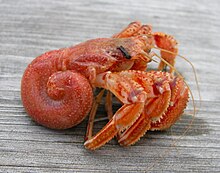Common Hermit Crab
| Common Hermit Crab | ||||||||||||
|---|---|---|---|---|---|---|---|---|---|---|---|---|

Common Hermit Crab ♂ ( Pagurus bernhardus ) |
||||||||||||
| Systematics | ||||||||||||
|
||||||||||||
| Scientific name | ||||||||||||
| Pagurus bernhardus | ||||||||||||
| ( Linnaeus , 1758) |
The Common hermit crab ( Pagurus bernhardus , Syn. : Eupagurus bernhardus ) comes in soft and hard floors, in creeks and tidal pools in the northern and western Baltic Sea , the English Channel , on the European Atlantic coast and on the shores of the Mediterranean before.
features
It has two pairs of antennas, the second of which is very long, a pair of scissors that are of different sizes, and two pairs of powerful walking legs. The back of the body is soft-skinned and is hidden in snail shells for protection . The two pairs of legs behind the two pairs of legs are significantly reduced in size and have adhesive bristle fields at the end. They serve to hold the snail shell in place. The much larger scissors on the right are mainly used to close the snail shell opening when the cancer withdraws in dangerous situations. The smaller left scissors serve as gripping scissors when eating; she guides the bites to the mouth opening. The common hermit crab is a filter feeder and omnivore that also eats carrion. It becomes ten centimeters long and is yellow, brown or reddish in color.
As the hermit crabs grow, they have to change shell. Larger specimens use case of whelks . The snail shells are often populated by colonies of the spiny polyp , a cnidarians . This polyp also overgrows the outer edge of the housing and thus enlarges it so that the crabs can inhabit the housing longer. Other cnidarians such as the parasite rose are also found on the shells. Since both animals benefit from it - the cancer is protected by the nettle capsules and the cnidarians are constantly carried to new sources of food - the relationship can be described as a symbiosis .
Sensation of pain
Scientists in the UK have found that the Common Hermit Crab can feel pain and has a pain memory . The animals were made to leave their homes by electric shocks. In the subsequent search for a new snail shell, the crabs examined it much more superficially than these animals normally do. This behavior was interpreted to mean that they specifically reacted to the negative experience. Based on the results, the scientists derive an increased need for action to protect crustaceans.
Individual evidence
- ↑ The Cancer Suffering. In: Wissenschaft.de. March 28, 2009, accessed September 8, 2019 .
literature
- Klaus Janke, Bruno P. Kremer: Dunes, beaches and mud flats, animals and plants on our coasts. Kosmos Verlag, ISBN 3 440 09576 2
